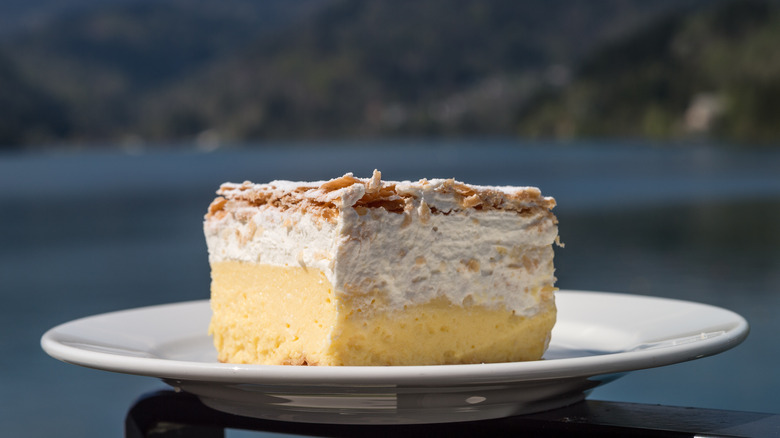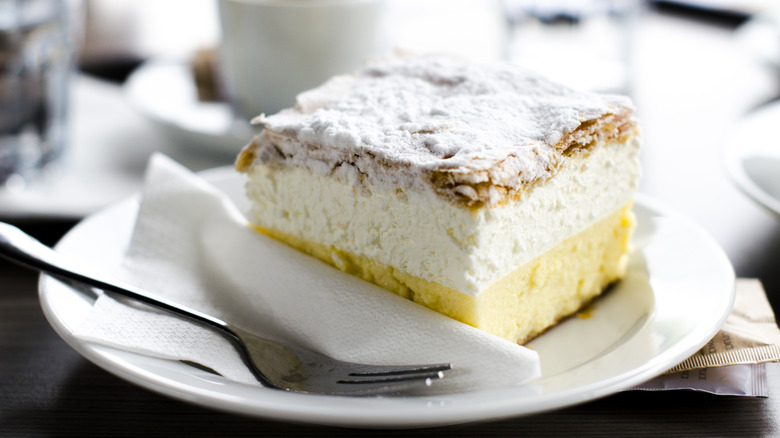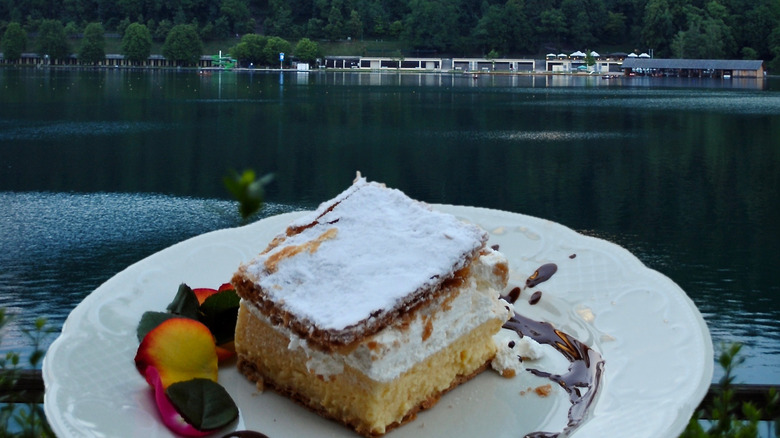Kremšnita Is A Creamy Cake Croatians Love
Black risotto, chunky fish stew, Kulen sausage, and many other gems make up Croatian cuisine. With big, hearty dishes teeming with olive oil and seafood, there are many instances where Croatian dishes resemble Italian flavors and styles. Yet, their desserts and sweets are just as remarkable. There is one, in fact, that appears exceptionally cherished: Kremšnita.
Also known as Samoborska kremšnita, the term kremšnita derives from cremeschnitte, which means mille-feuille in German. If you're unfamiliar with mille-feuille, it's a dreamy French dessert that's flaky and creamy. Although kremšnita's name developed from mille-feuille, its structure, textures, and tastes differ slightly.
Sandwiched between two layers of delicate puff pastry is one thick layer of custard, often topped with a layer of whipped cream. This delectably fluffy-foamy consistency is achieved by folding whisked egg whites into the custard. It's sweet and flaky while retaining a certain lightness. It simply melts in your mouth. It's an iconic Croatian dessert that's exceptionally popular amongst both locals and tourists, so much so that it's even been noted in poetry.
The origins of this pastry
The revered kremšnita is believed to have been invented by a pastry chef named Đuro Lukačić who studied the art of pastry making in Zagreb, the capital of Croatia. Lukačić then traveled to the Croatian city of Samobor (which is where the name Samoborska kremšnita derives), where it is believed that the first kremšnita was made during the 1920s. It's thought to have been created in celebration of the city, and as of January 2021, Samoborska kremšnita indeed achieved official recognition as an "intangible cultural property of Croatia."
Đuro Lukačić prepared kremšnita until 1966 when he imparted his craft to two pastry chefs, Višnja Vukmanović and Branka Žganjer. These individuals then passed down their knowledge to Kavana Livadić and the pastry shop U Prolazu in Samobor, which brings us to the present day where many local bakeries serve the delicacy. It's a rather agreed-upon thought amongst locals that the best and only kremšnita you should eat is from Samobor. If you get the chance to visit Croatia, this must surely be on your list.
Other variations across Europe
The origins of kremšnita are somewhat contested, as custard filling between puff pastries is seen in various forms across Central Europe. Slovenia claims their version of kremšnita — also known as kremna rezina, Bled cream cake, or Blejska kremšnita – is fluffier, creamier, and utterly more divine than the Croatian variety. It's believed Chef Ištvan Lukačević, a native of Serbia, invented the cake when he arrived in Slovenia after World War II. After working as a pastry chef in the Ravnik bakery where he learned various family recipes inspired by the bakery owner's travels through Austria and Germany, Lukačević developed his own and began to prepare it upon his appointment at the Park Hotel in Bled in 1953. Since then, approximately 15 million slices have been sold, and it has gained recognition as a regional symbol.
Yet some theories believe a version of this cake was present almost a whole century before Lukačević invented it. Several references indicate that Austrian Emperor Franz Joseph, who reigned from 1848 to 1916, enjoyed a sweet dessert matching the description of the kremšnita: Crispy, creamy, and with a delectable vanilla filling.
Cooking is all about the culinary journey: Developing recipes, learning and adapting techniques, trying new flavor combinations, and striving to create a dish that's delicious and thoughtful. It's no surprise that the kremšnita cake's origins are difficult to pinpoint, yet what is recognizable is how beloved and celebrated it is.


